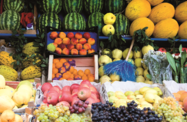A drive to restructure Turkey’s agricultural sector that includes ambitious plans to expand fruit and vegetable production is set to open the door for foreign investors looking to meet growing demand back home. Plans to drill new geothermal wells this year to help boost greenhouse production should further increase exports. However, the expansion is also prompting concerns that the introduction of new technology could lead to job losses.
Buoyed by favourable geographic conditions and abundant rainfall, Turkey’s agricultural sector contributed $62bn to the economy in 2012, after growing steadily over the past three years on the back of significant government investment in major irrigation and infrastructure projects.
The South-eastern Anatolian Project (Güneydoğu Anadolu Projesi, GAP), a regional sustainable development scheme, has played a major role in strengthening Turkey’s agricultural industry by providing infrastructure, planning and education for farmers.
Since it was first set up in 1987, GAP has expanded into a TL42bn ($23.7bn) initiative that offers training to farmers in contemporary irrigation and cultivation techniques, while providing them with modern tools and equipment. The scheme has helped push up agricultural exports from $1.7bn in 2002 to $5bn in 2010, excluding processed food, according to Invest in Turkey.
Foreign direct investment (FDI) in the agriculture sector has also risen significantly over the years, reaching $2.1bn in the first 10 months of 2012, up from $14m in 2002, according to the agriculture minister, Mehdi Eker.
The south-eastern city of Şanlıurfa has benefitted significantly from GAP by using the scheme’s land consolidation projects and irrigation systems to transform itself into a hub for greenhouse fruit and vegetable production. With demand for produce in Europe rising, many EU states are now eyeing the region’s investment potential.
Currently, a total of 54.216 ha have been allocated to greenhouse production in Turkey, which ranks fourth for fresh vegetable cultivation in the world. The country sits 11th on the global list for fruit production.
Turkey took steps to boost its greenhouse production in 2000 by drilling 54 geothermal wells in the south-east. Today, geothermal greenhouses in Şanlıurfa hold a 24.5mw capacity over an area of 106,000 sq metres. However, with Europe constantly looking to increase its imports of tomatoes, cucumbers, peppers and herbs produced by hydroponics, demand is outstripping supply.
Keen to boost capacity, Turkey plans to drill new geothermal wells in Şanlıurfa this year which should provide investment opportunities for up to 1500 new greenhouses, according to Müslüm Yanmaz, president of the GAP Greenhouse Association. “In the past two years, investors from Holland, Dubai and Kuwait have put in offers to invest in greenhouse fruit and vegetable production, but we haven’t had the geothermal capacity to be able to embark on such ventures,” he said.
While the initiative will help the industry’s development, concerns have been raised that mechanisation and techniques aimed at modernising agriculture could result in job losses. Some 6.2m people work in Turkish agricultural fields, which are spread over 24m hectares of land, according to the ministry of agriculture.
Demir Sarman, CEO of Anadolu ETAP, a food processing and fruit cultivation company, told OBG that while innovation could reduce the need for manual labour, this does not necessarily mean that workers would be left jobless.
“The introduction of new technologies in the agricultural business has indeed led to a certain amount of labour dislocation,” Sarman said. “Yet, while farms in Turkey are using fewer employees, food and beverage manufacturing plants have steadily increased their personnel. Increased productivity in agribusiness through use of technology and educated manpower has also helped Turkish producers lower their costs, thus strengthening Turkey’s competitiveness in international markets.”
To date, Turkey’s competitive workforce has proved popular with investors, who find it well suited to labour-intensive food production. Yanmaz added that he expected the increase of greenhouses in 2013 to help provide employment for farmers displaced through modernisation of the sector. The ministry has also said it expects its own workforce to expand by 2500 in 2013.
Turkey’s agriculture ministry will be spearheading plans to support small and medium-sized enterprises (SMEs) operating in the sector as part of a broader initiative to fight global food inflation. The European Bank for Reconstruction and Development (EBRD), supported by additional funds from the US, has also launched a €400m ($533m) facility to increase lending for smaller-sized farms, while Turkey’s DenizBank signed a €40m ($53.3m) credit line to offer loans to farmers.
The government has set the agriculture sector a two-fold target for the next decade of raising its GDP contribution to $150bn and increasing exports to $40bn. If achieved, the plan, which forms part of a broader set of objectives to be met by 2023 when the country celebrates 100 years as a republic, will set Turkey on track to reach an additional long-term goal of becoming one of the world’s top five countries for agricultural production.

